January 21st, 2008
Back in June 2007, a few GWAPA members went down to Florida to see what kinds of plants/fish we could find for our aquariums. One plant that was absolutely everywhere was a Hydrocotle species that mixed into the grass of people’s lawns, and existed in virtually every roadside ditch we visited. I grabbed a small amount, expecting it to completely take over my tank.
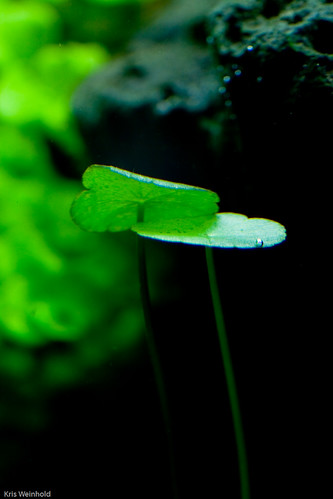
I couldn’t have been more wrong. This small plant has been living in my 40G tank for over 6 months, while only throwing up a single new stem. Recently, I upgraded my lighting to a 2x96W setup from AHSupply and I’ve noticed that the Hydrocotle sp. has started to grow, sending up a new stem and leaf in just the last week. Right now, the stems are approximately 6 inches tall, which is slightly taller than I’d prefer them. I’ll be sure to post if it evens out, and becomes a nice accent plant in my aquascape.
Posted in 40G Tank Log, Florida, Plant Profiles | 2 Comments »
January 9th, 2008
Bolbitis species have long been regarded as a low-light, undemanding plant, that survives in most aquariums. It’s a nice looking fern, adds a deep green to the tank, and can be attached to driftwood, or other hardscape materials. A couple months ago, a species of Bolbitis showed up at a GWAPA meeting that our club hadn’t seen before. This is what I’m calling Bolbitis sp., since I don’t know the proper name.
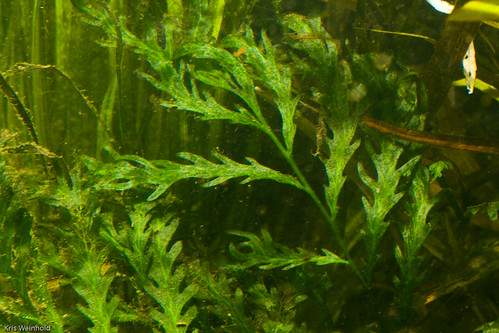
At first, we suspected that it was a terrestrial fern, but due to the quantity brought to auction, it was clear that it grow just fine underwater. It was sent to the club by a rainbowfish breeder and collector, who happened to order it from an order source. The leaf form has many more indentations than the usual type. I’ve been keeping it in my 75G aquarium, and growth has been quite slow, but it is growing nevertheless. If anyone can identify the species of this bolbitis, please leave a comment.
Posted in 75G Tank Log, Plant Profiles | 3 Comments »
January 7th, 2008
My new favorite accent in the 75G aquarium is Rotala macrandra, a beautiful, but delicate red stem plant. Notorious for being a more difficult plant to grow, I can understand its’ reputation. The plant doesn’t seem to have much of a problem growing, but if I go too long without a water change, I start to notice little holes in the leaves.

Additionally, leaves that reach the surface, appear to easily get holes, or fall apart, instead of converting to emersed growth. That may also be due to the heat from the light as they get rather close to them. Nevertheless, it is a gorgeous plant, with striking orange and red tones. I started with a single stem, and in just a month or two, I’ve now got a decent sized bush of R. macrandra. I’m hoping to grow it out even further, as I need more red in my 75G to offset the large number of green plants in there.
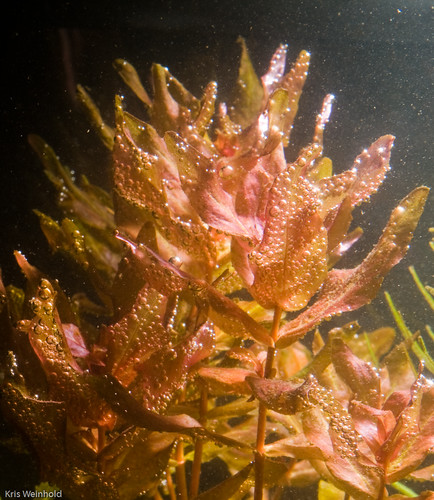
Fortunately, R. macrandra has been in the hobby for some time, so it often shows up in some of the more ambitious fish shops. It you have the chance to buy it, do. However, make sure that you have adequate lighting, CO2, and fertilizers, or the plant won’t stand a chance.
Posted in 75G Tank Log, Plant Profiles | 9 Comments »
January 1st, 2008
A couple of weeks ago, I got some shrimp from another GWAPA member, and in the bag, he sent along a nice new species of Hygrophila for me to try out. We don’t know the exact species name, but it’s being referred to as Hygrophila sp. ‘Low grow’, due to the way that it grows compared to some other Hygro’s.

The plant seems to creep along the substrate, even in more high light conditions. I’ve grown the common Hygrophila polysperma in this same fashion before, but it requires constant trimming to maintain it low to the ground. This ‘Low grow’ does not appear to need the same. In addition, I’ve found it to be a much slower grower than other species of Hygrophilia which can be outright weeds if left unchecked. The leaves are larger than that of H. polysperma, and contain more pronounced (prettier) vains.
Due to the leave size, I may not use it in many of my aquascapes, but it might be perfect for some larger scapes. I’m going to wait to to let it further grow out before I fully decide that, however.
Posted in 75G Tank Log, Plant Profiles | 1 Comment »
December 8th, 2007
The Utricularia graminifolia is starting to grow in in the 75G tank. It’s still not really that full, but you can start seeing some little leaves pop up from the aquasoil substrate. My theory is that this plant takes longer than others to get going because it requires a more mature tank with more microorganisms to get caught in its bladders. Of course, I can’t say that I’ve grown it predictably enough to have it fully understood at this point.
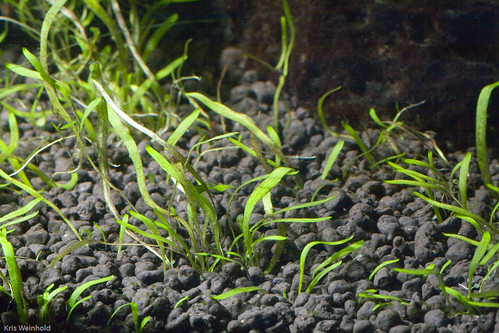
What I know is that that once I start seeing “trailers” like the ones below, that that plant is well on its way to filling in. I’ve also had a number of “trailers” growing up into the water column, making the foreground look too tall and shabby, but I’ve gradually cut those off and replanted them in the bare areas to try and get them going.
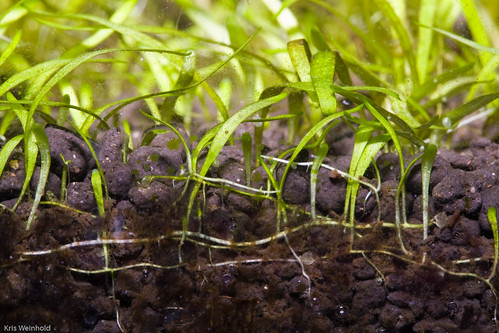
Additionally, the Nannochromis nudiceps seem to have gotten over their digging fascination, so they’re no longer pulling up, or covering up, the Utricularia graminifolia directly in front of their “underground lair.”
Posted in 75G Tank Log, Plant Profiles | Comments Off on Utricularia graminifolia
November 1st, 2007
Here’s my 40G tank after being setup about 3.5 weeks ago.
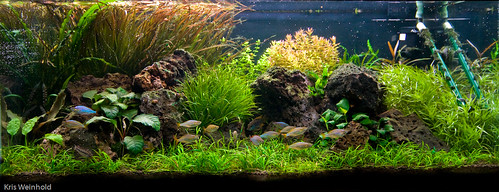
The Blyxa aubertii is still plagued by some hair/staghorn algae, but that’s because I still haven’t gotten a powerhead to add some more flow to that part of the tank. The Rotala macrandra var. ‘green’ is looking fantastic in the back middle, as is the Blyxa japonica. I’m still trying to determine whether or not I’m able to use the Potamegeton sp. from Florida as a scapable plant. It’s to the right of the R. macrandra ‘green’ below.
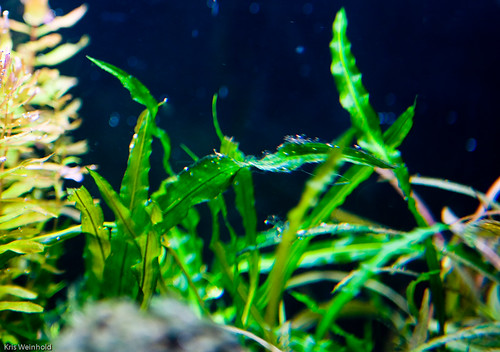
It grows a bit too fast to easily time for a photo, but in a huge mass of stems, I think it would look like a stand of crypts with red/browns/yellows/greens throughout. When we first collected it, it looked very much like a bed of crypts with the leaves coming straight from the substrate, where the roots spread by runners. I’ve yet to replicate that growth in my tank, where the plant grows much more as a stem with a few long leaves coming off at alternating nodes. A foot long stem to the surface might only have 3-4 leaves, each of 4-5″ in length. I guess that’s why they called Potamegetons “pond weeds.”
I’d love to hear comments about how the tank is progressing, and would welcome any suggestions for the future.
Posted in 40G Tank Log, Plant Profiles | 1 Comment »
October 7th, 2007
At one of the past GWAPA meetings, I won Hygrophila sp. ‘Sarawak’ in the mini-auction. One of our members had obtained seeds for this plant, grew it up emersed, and finally started propagating it for other club members. When I obtained this plant, it was in its emersed form which has much larger green leaves than the reddish submersed form. In the picture below you can see the contrast of the larger leaf form at the bottom verses the leaves at the top.
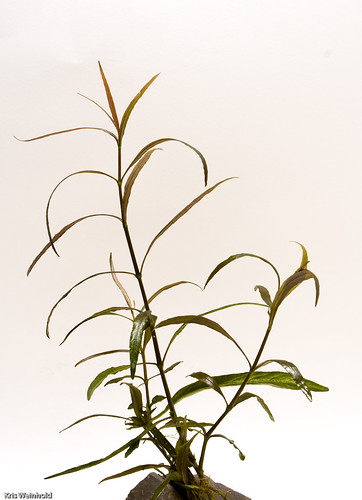
Most of us know the plants of the Hygrophila genus as weeds that require frequent trimming and care. For this reason, I usually avoid plants from this family. I’m pleased to report that Hygrophila sp. ‘Sarawak’ does not share this same trait. It is much slower growing than say, H. polysperma, and so it requires much less upkeep. I’m still reserving judgment on how apt this plant is for aquascaping, but my first impression seems to indicate that it will bush up, making it viable. Watch future posts of my latest 40G aquascape to see how it progresses along.
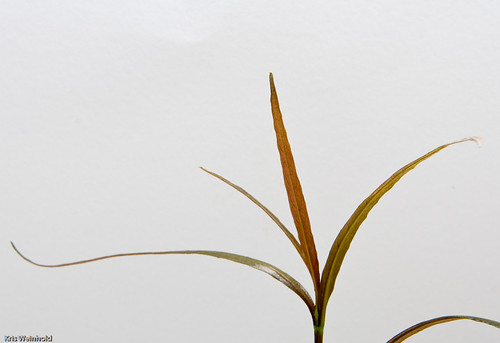
Posted in 40G Tank Log, Plant Profiles | 4 Comments »
October 1st, 2007
I promise that this is going to be my last post about Pogostemon yatabeanus flowers for awhile! I previously showed how the flower pod itself grows from the top of the plant. Now, that pod is bursting open with these very feathery, purple flowers. They’re very pretty with multiple plants starting to burst open.
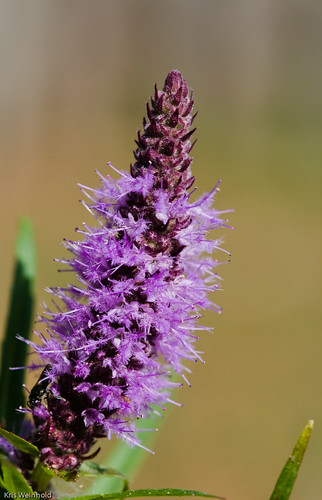
And, the flowers are attracting plenty of nectar-loving insects to the pond. If you hold your nose close to the flower, you can smell a very sweet aroma that’s much like the flowers in your typical grocery store bouquet. (Sorry, I don’t know which flower it smells like, but it’s familar.) I may try to collect seeds at the end of the season, just for the sake of growing them again indoors in my very small emersed setup.

Posted in Plant Profiles, Raised Brick Pond | 1 Comment »
September 29th, 2007
Last night I went over to my friend Aaron’s house to help him get a good photograph of his aquascape for the Aquatic Gardener Association’s aquascaping contest due in a few days. I promised him that I wouldn’t post any pictures of his actual aquascape until after the contest is over, but these are some individual plant shots I took.

The first shows HC, Hemianthus callitrichoides, pearling with a nice fat oxygen bubble on its’ leaf tip. If you look closely you can see some of the downoi reflected in the bubble. Below is a picture of a very healthy looking Rotala macrandra var. ‘Green,’ also pearling away. I’m going to have to go back and take more pictures because Aaron’s got some really awesome plants growing in his tanks. Good luck in the contest Aaron!
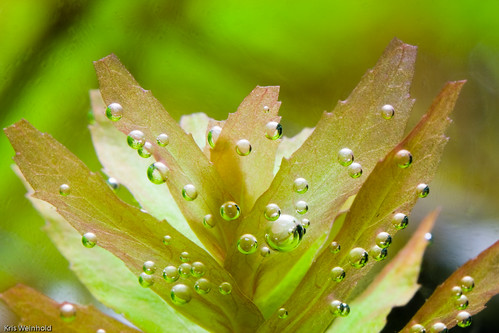
Posted in General, Plant Profiles | 4 Comments »
September 16th, 2007
You may think that lately this has been a flower blog, but I guess it’s just that time of year because today, I noticed several stalks of the Pogostemon yatabeanus have produced flowers. I’ll admit that this is the plant I’ve most anticipated seeing flower because these stems were the first to eagerly shoot above the surface in emersed growth this past spring.

Each P. yatabeanus seems to produce a single flower, coming directly out of the top of the plant. The flower itself looks very much like that of an anubias flower, except that it has purple sections alternating throughout. I suspect that those purple sections will eventually become seeds.

Currently, the flowers are all still mostly hidden by surrounding leaves. I’ll be sure to post new pictures if it grows into anything more than a larger version of what’s in this post.

Posted in Plant Profiles, Raised Brick Pond | 1 Comment »

















